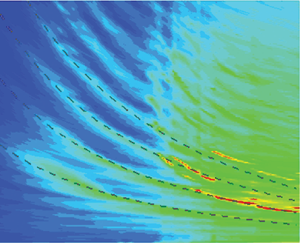Article contents
Pressure fluctuations due to ‘trapped waves’ in the initial region of compressible jets
Published online by Cambridge University Press: 29 November 2021
Abstract

An experimental study is conducted on unsteady pressure fluctuations occurring near the nozzle exit and just outside the shear layer of compressible jets. These fluctuations are related to ‘trapped waves’ within the jet's potential core, as investigated and reported recently by other researchers. Round nozzles of three different diameters and rectangular nozzles of various aspect ratios are studied. The fluctuations manifest as a series of peaks in the spectra of the fluctuating pressure. Usually the first peak at the lowest frequency (fundamental) has the highest amplitude and the amplitude decreases progressively for successive peaks at higher frequencies. These ‘trapped wave spectral peaks’ are found to occur with all jets at high subsonic conditions and persist into the supersonic regime. Their characteristics and variations with axial and radial distances, jet Mach number and aspect ratio of the nozzle are documented. For round nozzles, the frequency of the fundamental is found to be independent of the jet's exit boundary layer characteristics and scales with the nozzle diameter. On a Strouhal number (based on diameter) versus jet Mach number plot it is represented by a unique curve. Relative to the fundamental the frequencies of the successive peaks are found to bear the ratios of 5/3, 7/3, 9/3 and so on, at a given Mach number. For rectangular nozzles, the number of peaks observed on the major axis is found to be greater than that observed on the minor axis by a factor approximately equal to the nozzle's aspect ratio; the fundamental is the same on either edge. For all nozzles the onset of screech tones appears as a continuation of the evolution of these peaks; it is as if one of these peaks abruptly increases in amplitude and turns into a screech tone as the jet Mach number is increased.
JFM classification
Information
- Type
- JFM Papers
- Information
- Copyright
- © The Author(s), 2021. Published by Cambridge University Press
References
- 28
- Cited by


